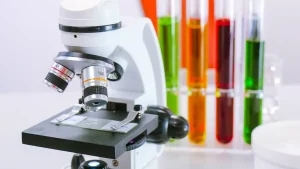リサイクルSiCの焦点 リングは、貴重なリソースを節約するために重要な役割を果たしています。 高抵抗性炭化ケイ素から作られたこれらのリングは、優れた耐久性と安定性を発揮し、再利用に最適です。 堅牢な組成物は、原材料抽出の必要性を減らし、メーカーは生産コストを削減するのに役立ちます。 また、廃棄物発生を最小限に抑え、循環経済を支えます。 高品質の材料を製造サイクルに再導入することにより、産業は環境のフットプリントを大幅に削減しながら、より効率的な生産を実現します。 この持続可能なアプローチは、企業と惑星の両方の長期的な利益を保証します.

要点
- リサイクルSiCの焦点 リングは、高品質の炭化ケイ素を製造サイクルに還元し、原料抽出の必要性を削減することにより、貴重な資源を節約します.
- SiCフォーカスリングの耐久性により、従来のシリコンリングよりも長持ちし、廃棄物を最小限に抑え、製造コストを削減できます.
- 循環型経済を支えるだけでなく、半導体製造の環境フットプリントを大幅に削減する効率的なリサイクルプロセスの実装.
- 高度のクリーニングおよび再処理の技術はリサイクルされたSiCの焦点リングが生産の操作上の効率を高める彼らの質を維持することを保障します.
- リサイクルプログラムへの投資は、既存の材料を回復すると、新しい原材料を調達するよりも安価なため、大幅にコスト削減につながることができます.
- エネルギー効率の高い炉などのエマージ技術は、リサイクルプロセスを改善し、半導体メーカーにとってよりサステナブルで効果的です.
- SiCフォーカスリングのリサイクルを優先することにより、半導体の需要増加に対応しながら、業界はグローバルサステイナビリティの目標に合わせることができます.
SiCフォーカスリングとは?
シリコンカーバイド(SiC)フォーカスリングは、半導体製造工程において欠かせない部品です。 高抵抗性炭化ケイ素から作られたこれらのリングは、プラズマエッチングシステムにおける重要な役割を果たします。 半導体デバイス製造時の精度と効率性を確保 これらのリングの需要は、電子機器、自動車、通信などの業界における半導体の信頼性が高まっています.
SiCフォーカスリングの目的
SiCの焦点 リングは、ウェーハのエッジの周りのエッチングの均一性を改善することにより、プラズマエッチング装置の性能を高めます。 この均一性は、半導体デバイスの品質と一貫性を維持するために不可欠です。 汚染を最小化し、メンテナンスを中止することにより、これらのリングはよりスムーズな製造作業に貢献します。 耐久性は、過酷な化学洗浄と極端な熱条件に耐えることができ、高度なウェーハ製造プロセスに不可欠です.
SiCフォーカスリングの構成と特性
SiCの焦点リングの構成は密で、耐久力のある炭化ケイ素を含んでいます。 この材料は熱衝撃への例外的な硬度、熱伝導性および抵抗を表わします。 これらの特性はリングが半導体製造の要求条件に耐えることを可能にします。 炭化ケイ素の高耐食性は頻繁な取り替えのための必要性を減らす長寿を更に高めます。 メーカーは、生産コストを削減し、運用効率を向上させるために、これらの特性から恩恵を受けています.
SiCの焦点リングの主な特徴:
- 高い抵抗性炭化ケイ素の構造.
- 優れた熱伝導性と耐衝撃性.
- 延長耐久性のための優秀な耐食性.
- エッチングの均一性を維持し、汚染を最小限に抑える能力.
これらの特徴のユニークな組み合わせにより、SiCフォーカスリングは、プロセスを最適化し、一貫した結果を達成することを目指し、半導体メーカーにとって好まれる選択肢になります.
SiCフォーカスリングのリサイクルプロセス
使用されるSiCの焦点リングのコレクションそして分類
半導体製造設備から使用されるSiCフォーカスリングの回収からリサイクルプロセスが始まります。 これらのリングは、特定の使用期間後に交換されることが多いため、廃棄物として終わることはありません。 製造業者およびリサイクルパートナーは、効率的な収集システムを確立するために協力します。 ソートは、リングが条件と材料組成に基づいて分類されるコレクションフェーズに従います。 このステップは、高品質のシリコンカーバイドコンポーネントだけが次の段階に進むことを確実にし、リサイクルプロセスを最適化します.
事実: SiCの焦点 耐久性に知られるリングは、通常、純シリコンリングよりも長持ちします。 シリコンリングは10〜12日ごとに交換が必要ですが、SiCリングは最大15〜20日間耐え、廃棄物を減らし、効率性を高めます.
リサイクルの清掃と準備
一度ソートすると、使用されるSiCフォーカスリングは、化学残留物や残骸などの汚染物質を除去するために徹底的にクリーニングを受けます。 化学および熱処置を含む高度のクリーニングの技術は、リングを元の純度に元通りに元通りにします。 リサイクル材料の品質を損なう可能性があるため、このステップは重要です。 クリーニング後、再処理のためにリングを準備します。 この準備は、構造の整合性のためのリングを検査し、リサイクルに必要な基準を満たしていることを確認します.
主なインサイト: 化学蒸気蒸着(CVD)を介して生成されたもののような高純度のコンポーネントは、リサイクル中にSiCフォーカスリングのパフォーマンスを維持するために不可欠です。 CVDプロセスは、半導体アプリケーションにとって重要な均一性と安定性を保証します.
製造における再加工・再利用
最終段階は、洗浄されたSiCフォーカスリングを再処理し、再使用可能な材料に関与します。 ハイテク炉は、このフェーズでピボタル役割を果たし、エネルギー効率の高い方法で炭化ケイ素の回復を可能にします。 再処理された材料は元の指定に一致させる新しい焦点リングを作成するためにそれから形成されるか、または上塗を施してあるです。 これらのリサイクルリングは、製造サイクルを再入力し、循環経済をサポートし、原材料の需要を減らす.
環境のメリット: SiCフォーカスリングをリサイクルし、廃棄物を最小限に抑え、半導体製造の環境影響を低減します。 価値ある材料を生産に再導入することにより、産業はより持続可能な資源効率を実現します.
SiCフォーカスリングをリサイクルするメリット
資源の保全とサステナビリティ

リサイクルSiCの焦点 リングは貴重なリソースを大幅に節約します。 高品質の炭化ケイ素を製造サイクルに再導入することにより、産業は原料抽出に依存します。 自然保護を保ち、採掘活動による環境負担を最小限に抑えます。 SiCフォーカスリングの耐久性は、持続性を高めます。 頻繁な交換を必要とするシリコンリングとは異なり、SiCリングは長持ちし、廃棄物発生と材料消費を削減します.
事実:SiCリングは、シリコンリングの10〜12日寿命と比較して、長寿のシリコンリングを抜きます。 資源の効率化と廃棄物削減に貢献します.
循環型経済モデルの循環型経済モデルのリサイクルにも貢献します。 使用されるリングを捨てる代わりに、メーカーは再使用可能なコンポーネントに変換します。 このアプローチは、半導体製造における持続可能な実践を促進するためのグローバルな取り組みと整合します.
メーカーのコスト効率
リサイクルSiCの焦点 リングは、メーカーにとって大きなコスト削減を実現します。 原材料からの新しいリングを生産することで、材料調達や加工により高額なコストを伴います。 一方、リサイクルは既存の材料を回復し、再処理することによって、これらのコストを削減します。 新たな材料のリサイクルをと比較すると、経済上の利点が明らかになります。 たとえば、c-Si PVモジュールをリサイクルすると、純経済のメリットが得られます。また、新素材のコストを大幅に削減します.
洞察: 生産費を削減するだけでなく、廃棄物処理や環境への影響に関連する外部コストを緩和する.
SiC の焦点リングの延長耐久性は更に費用効率を高めます。 彼らの長い寿命は交換の頻度を減らします、製造業者は資源をより効果的に割り当てることを可能にします。 リサイクルプログラムに投資することで、高品質の生産基準を維持しながら、長期にわたる金融利益を達成します.
リサイクル環境のメリット
リサイクルSiCの焦点 リングは、半導体製造の環境の足跡を減らす上で重要な役割を果たしています。 工程は、使用済みリングを埋め立て、生産サイクルに再導入することで廃棄物を最小限に抑えます。 生態系に害を及ぼす非生物分解性物質の蓄積を防止します.
ハイテク炉の使用などのエネルギー効率の高いリサイクル方法により、再処理段階での排出量をさらに削減します。 これらの技術は、リサイクル材料の品質を維持しながら、環境への影響が最小限に抑えられることを保証します。 さらに、リサイクルは、多くの場合、生息地の破壊と汚染につながる原料抽出の必要性を減少させます.
環境への影響: SiCフォーカスリングのリサイクルは、クリーンな製造プロセスをサポートし、グローバルサステイナビリティの目標と整列します。 半導体の需要が高まる中、産業は、この慣行を採用することにより、より緑豊かな未来に貢献します.
廃棄物削減、エネルギー効率、資源の保全の総合的メリットは、持続可能な製造のための重要な戦略をリサイクルします。 経済成長と経済成長のバランスをとりながら、産業が経済成長に寄与する.
SiCフォーカスリングのライフサイクルを拡張
SiCフォーカスリングのライフサイクルを拡張することで、半導体メーカーの経済的および環境的成果が向上します。 これらのリングは、優れた耐久性で知られており、長寿に伝統的なシリコンリングを上回っています。 シリコンリングは10〜12日ごとに交換が必要ですが、SiCリングは最大20日間持続できます。 この延長寿命は、交換の頻度を減らし、リソースを節約し、運用コストを削減します.
メーカーは、高度なメンテナンスとリサイクルの実践を実施することにより、SiCフォーカスリングのライフサイクルをさらに拡張することができます。 定期的な清掃と検査により、リングは構造の整合性と性能基準を維持します。 化学蒸気蒸着(CVD)を介して生成されたものなどの高純度のコンポーネントは、使用中のこれらのリングの品質を維持し、フェーズをリサイクルする際に重要な役割を果たします。 メンテナンスを優先することにより、メーカーはリサイクルプロセスを開始する前に、各リングのユーティリティを最大限に活用することができます.
リサイクルは、SiCフォーカスリングのライフサイクルを延ばすためにも大幅に貢献します。 プロセスは新しい原料のための必要性を減らす生産周期に良質の炭化ケイ素を、作り出します。 ハイテク炉およびエネルギー効率の高い方法は、材料の回復を妥協することなく可能にします。 このアプローチは、捨てられたものではなく、資源を再利用する循環経済の原則と整列します.
経済インサイト: SiCフォーカスリングをリサイクルすると、コストを大幅に削減できます。 例えば、c-Si PVモジュールのリサイクルは、新しい材料を使用するUSD 12.43 / m2コストと比較して、USD 1.19 / m2の純経済利益をもたらします。 新たな資源に頼りに、リサイクルの金融優位性を発揮します.
SiCフォーカスリングのライフサイクルを拡張することにより、メーカーは複数の利点を達成します。 廃棄物の削減、省資源化、生産コストの削減 これらの慣行は、運用効率の向上だけでなく、持続可能性の目標をサポートし、半導体製造の将来に不可欠です.
SiCフォーカスリングをリサイクルするチャレンジとイノベーション
SiC材料のリサイクルに関する共通の課題
シリコンカーバイド(SiC)材料をリサイクルすると、革新的なソリューションが必要な課題がいくつかあります。 SiCフォーカスリングの耐久性に大きな障害があります。 半導体製造に有利な中堅牢な組成物は、リサイクルプロセスを複雑化します。 SiCの高硬度・耐熱性により、分解・再加工が難しくなります。 品質を損なうことなく、これらの材料を処理するために、特殊な装置と技術が必要です.
もうひとつの課題は、汚染から成ります。 使用されるSiCの焦点リングは頻繁にライフサイクルの間に化学残余および残骸を集めます。 これらの不純物は回復された材料の質を減らすリサイクル プロセスと干渉できます。 高度な洗浄方法は、リサイクルされたSiCの純度を確保するために採用されなければなりません, プロセスに複雑さとコストを追加します。.
リサイクルインフラの限られた可用性もハードルを貫く。 多くの半導体メーカーは、SiC材料をリサイクルする設備へのアクセスが欠如しています。 この制限は、環境廃棄物に寄与する伝統的な処分方法の信頼性で行われます。 リサイクルセンターの広範なネットワークの構築は、この問題に対処し、持続可能な実践を促進するために不可欠です.
事実: SiCの焦点 シリコンリングと比較して長寿命で知られるリングは、15〜20日ごとに交換が必要です。 この耐久性は、廃棄物を減らすだけでなく、材料を効果的に管理するために高度なリサイクル方法が必要である.
リサイクル技術・イノベーション
リサイクル技術の革新は、SiCフォーカスリングを処理するより効率的で持続可能な方法のための方法舗装されています。 ハイテク炉は、リサイクルプロセスにおけるゲームチェンジャーとして登場しました。 これらの炉は、エネルギー効率の高い方法で炭化ケイ素の回復を可能にし、環境への影響を最小限に抑えます。 素材の完全性を維持することにより、メーカーは、元の仕様を満たすリサイクルリングを生産することができます.
研究者はまた、炭化ケイ素の代替源を探求しています。 たとえば、埋め立てで廃棄されるCDは、SiCを合成するためのカーボンソースとして機能することができます。 廃棄物を削減するだけでなく、高品質のSiC材料を製造するための費用対効果の高い方法を提供します。 このような情報源から得られるナノ構造のSiCの使用は、フィールドエミッションディスプレイやセンサーデバイスなどの高度な技術で潜在的なアプリケーションを持っています.
製造業者およびリサイクルの専門家間のコラボレーションは環境にやさしいリサイクルプロセスの開発につながっています。 これらの方法は、再処理段階での排出量の最小化とエネルギーの節約に重点を置いています。 半導体業界は、これらのイノベーションを一体化することにより、SiCフォーカスリングの需要が高まっています.
洞察: : : クォーツとシリコンからSiCへのシフトで、フォーカスリングは、業界における耐久性と効率性へのコミットメントを反映しています。 ドライエッチングは、ウエハ加工においてより普及し、SiC材料の需要は上昇し、リサイクル技術のさらなる進歩を促進します.
高度なリサイクル技術、代替材料のソース、および協調的な取り組みの組み合わせは、SiCリサイクルにおける課題の克服の可能性を強調しています。 これらのイノベーションは、現在の限界にとどまらず、半導体製造におけるより持続可能な未来に向けたステージを設定しています.
リサイクルSiCの焦点 リングは、半導体製造における持続可能性の高度化に向けた重要な戦略です。 重要なリソースを節約し、生産コストを削減し、環境害を緩和します。 汚染や限られたリサイクルインフラなどの課題に取り組むことで、SiC材料の可能性を最大限に引き出します。 廃棄物CDなどのエネルギー効率の高い炉や代替炭素源を含む新興技術は、リサイクル効率をさらに高めます。 半導体の需要が高まるにつれて、電気自動車や再生可能エネルギーシステムの革新によって推進され、SiC Focus Ringsをリサイクルすることで、持続可能な資源効率の高い製造の未来を実現します.
よくあるご質問
半導体製造に使用されるSiCフォーカスリングとは?
SiCの焦点 リングは、プラズマエッチング装置において重要な役割を果たしています。 ウェーハのエッジ周りのエッチングの均一性を高め、半導体製造時の精度と一貫性を保証します。 熱衝撃に対する耐久性と耐性は、高度な製造プロセスに不可欠です.
SiCフォーカスリングはシリコンリングとの違いは?
SiC の焦点は耐久性および寿命の面でシリコン リングを抜きます。 シリコンリングは通常10〜12日間続きますが、SiCリングは最大20日間耐えられます。 この延長寿命は、廃棄物を削減し、交換コストを削減し、メーカーにとってより費用対効果の高いオプションを提供します.
SiCフォーカスリングをリサイクルする理由は?
リサイクルSiCの焦点 リングは、貴重なリソースを節約し、環境への影響を削減します。 高品質の炭化ケイ素を生産サイクルに還元することで廃棄物を最小限に抑えます。 このプラクティスは、持続性をサポートし、循環経済の原則と整列します.
SiCフォーカスリングをリサイクルする課題は?
リサイクルSiCの焦点 リングは、化学残留物や材料の高硬度などの汚染などの課題を提示します。 これらの要因は、リサイクル材料の品質を確保するために高度なクリーニング技術と専門機器が必要です.
SiCフォーカスリングのリサイクルプロセスはどのように機能しますか?
処理は、使用されるリングの収集とソートから始まります。 不純物を取除くために十分にクリーニングの後で、リングはハイテクな炉で再処理を経ます。 回復された炭化ケイ素は元の指定を維持し、新しい焦点リングを製造するのにそれから使用されます.
SiCフォーカスリングをリサイクルする環境上の利点は何ですか?
リサイクルSiCの焦点 リングは廃棄物を削減し、非偏見性材料が埋め立てに蓄積するのを防ぎます。 エネルギー効率の高いリサイクル方法も排出量を削減し、クリーンな生産プロセスに貢献し、グローバルサステイナビリティの目標を支援します.
CDなどの廃材はSiCを生産することはできますか?
はい、廃棄CDは炭化ケイ素の合成のためのカーボン源として役立つことができます。 この革新的なアプローチは、埋め立て廃棄物を削減するだけでなく、優れた熱および機械的特性で高品質のSiC材料を製造するための費用対効果の高い方法を提供します.
SiCフォーカスリングは、製造効率を向上させる方法は?
SiCフォーカスリングは、エッチングの均一性を改善し、プラズマエッチング時の汚染を最小限に抑えることで、製造効率を高めます。 それらの耐久性は、メーカーがより少ない割込みで一貫した生産基準を維持できるように、交換の頻度を減らします.
SiCフォーカスリングのリサイクルを改善するイノベーションは何ですか?
ハイテク炉や環境に配慮したリサイクルプロセスなどの新興技術は、SiCリサイクルの効率化を図っています。 研究者は、廃棄物CDなどのシリコンカーバイドの代替ソースを探索し、持続可能な慣行をさらにサポートしています.
SiCフォーカスリングの使用は、業界のトレンドとどのように整列しますか?
シリコンからSiCフォーカスリングへのシフトは、業界での耐久性と効率性を重視しています。 半導体の需要が高まる中、電気自動車や再生可能エネルギーシステムの進歩によって推進され、SiC材料は、これらのニーズにお応えする重要な役割を果たしています.
製品の詳細については、下記までお問い合わせください。 steven@china-vet.com またはウェブサイト: www.vet-china.com.







